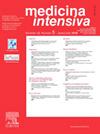Evaluación de los diferentes accesos vasculares en Unidad de Cuidados Intensivos Neonatales. ¿Es el catéter midline una alternativa útil para terapias prolongadas?
IF 2.7
4区 医学
Q2 CRITICAL CARE MEDICINE
引用次数: 0
Abstract
Objective
Analyze the usefulness of the midline catheter in terms of efficacy and safety for treatments lasting more than 3 days in the neonatal population requiring admission to the NICU.
Design
Analytical and observational of a prospective cohort (December 2021-November 2023) compared to a historical cohort (January 2020-November 2021).
Setting
9-bed Neonatal Intensive Care Unit (NICU, level III hospital.
Patients or participants
288, 66 midline group and 222 control group. Inclusion criteria: newborns from 24 to 42 weeks of gestation who required short peripheral or midline cannulation and treatment longer than 3 days.
Interventions
Follow-up during NICU stay and comparison with retrospective data from a historical cohort.
Main variables of interest
Sociodemographics, success rate (permanence of the same vascular catheter without complications until finish the prescribed treatment), number of catheters, cannulation rate per patient, indwell time, complications.
Results
The midline group showed a higher success rate (54.2% vs. 5.6%, P<.001), a lower number of canalizations per patient (P <.001), a longer indwell time (P<.001) and a lower number of extravasations (P<.001).
Conclusions
The midline catheter has advantages over short peripheral catheters, being a useful alternative in terms of efficacy and safety for treatments lasting more than 3 days in the neonatal population that requires admission to the NICU.
新生儿重症监护室不同血管通路的评估:中线导管是否是长期治疗的有效替代品?
目的分析中线导管在新生儿重症监护病房(NICU)治疗时间超过3天的新生儿群体中的有效性和安全性.设计分析和观察前瞻性队列(2021年12月至2023年11月)与历史队列(2020年1月至2021年11月)的比较.设置9张病床的新生儿重症监护病房(NICU,三级医院).患者或参与者288人,其中中线组66人,对照组222人.干预措施在新生儿重症监护病房住院期间进行随访,并与历史队列中的回顾性数据进行比较。主要关注变量社会人口统计学、成功率(在完成规定治疗前,同一血管导管无并发症的持久性)、导管数量、每位患者的插管率、留置时间、并发症。结果中线组的成功率更高(54.2% 对 5.6%,P<.001),每位患者的插管次数更少(P<.001),留置时间更长(P<.001),外渗次数更少(P<.001)。结论中线导管比外周短导管更有优势,在需要入住新生儿重症监护室的新生儿中,中线导管在疗效和安全性方面都是一种有效的选择,可用于超过 3 天的治疗。
本文章由计算机程序翻译,如有差异,请以英文原文为准。
求助全文
约1分钟内获得全文
求助全文
来源期刊

Medicina Intensiva
CRITICAL CARE MEDICINE-
CiteScore
2.70
自引率
20.00%
发文量
146
审稿时长
33 days
期刊介绍:
Medicina Intensiva is the journal of the Spanish Society of Intensive Care Medicine and Coronary Units (SEMICYUC) and of Pan American and Iberian Federation of Societies of Intensive and Critical Care Medicine. Medicina Intensiva has become the reference publication in Spanish in its field. The journal mainly publishes Original Articles, Reviews, Clinical Notes, Consensus Documents, Images, and other information relevant to the specialty. All works go through a rigorous selection process. The journal accepts submissions of articles in English and in Spanish languages. The journal follows the publication requirements of the International Committee of Medical Journal Editors (ICMJE) and the Committee on Publication Ethics (COPE).
 求助内容:
求助内容: 应助结果提醒方式:
应助结果提醒方式:


